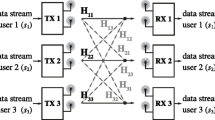Abstract
The European Telecommunications Standards Institute (ETSI) has recently defined a European standard for a high performance radio LAN (known as HIPERLAN). To operate as wired LAN replacements, these systems will operate at 5.2 GHz and support instantaneous bit rates of just under 24 Mb/s. To counteract the time dispersive nature of the indoor radio channel, the use of adaptive equalisation is suggested. In this paper a number of possible modulation and equalisation techniques are presented and, in particular, the Bit Error Rate (BER) performance of quasi-coherent GMSK combined with Decision Feedback Equalisation is explored through computer simulation. The trade off between symbol spaced and fractionally spaced equalisation is considered together with the importance of feedfoward and feedback synchronisation to the channel's power delay profile. The paper also includes a comparison of the RLS and LMS based training algorithms and compares the modem developed under the ESPRIT III LAURA project with that specified in HIPERLAN.
The application of dual antenna diversity is investigated and its impact on the number of received error free data packets obtained as a function of signal leval and rms delay spread. The use of such diversity is shown to greatly improve the BER performance of a HIPERLAN modem. The problem of frequency offset is considered and modifications are proposed to the HIPERLAN frame structure to improve the receiver's tolerance to such errors. Important practical issues such as frame and symbol synchronisation, frequency offset correction and hardware implementation are discussed from both the LAURA and HIPERLAN viewpoint.
Similar content being viewed by others
References
ETSI Radio Equipment and Systems, “High PErformance Radio Local Area Network (HIPERLAN)”, Functional Specification Version 1.1 (Draft), Jan. 1995.
A.R. Nix, G.E. Athanasiadou and J. McGeehan, “Predicted HIPERLAN Coverage and Outage Performance at 5.2GHz and 17 GHz Using Indoor 3-D Ray-Tracing Techniques”, to be published in the Wireless Personal Communications Journal, Kluwer Academic Publishers.
Y. Sun, A.R. Nix and J.P. McGeehan, “HIPERLAN Performance Analysis with Dual Antenna Diversity and Decision Feedback Equalisation”, 46th IEEE VTC, Atlanta, USA, April 1996, pp. 1549–1554.
M. Li et al., “LAURA Modem Design Issues”, ETSI, Paris, RES10/TTG/93/77.
M. Li et al., “Analysis of Inter Modulation Distortion Specification for Radio LANs using Multicarrier Schemes”, Electronics Letters, Vol. 29, June 1993.
A. Jones et al., “Study of Modulation Schemes for HIPERLAN”, COST 231, Limerick, Ireland, Sept. 1993.
A.R. Nix et al., “Modulation and Equalisation Considerations for High Performance Radio LANs (HIPERLAN)”, IEEE PIMRC, The Hague, Holland, pp. 964–968, Sept. 1994.
I.R. Johnson et al., “On Suitable Codes for Frame Synchronisation in Packet Radio LANs”, VTC 1994, Stockholm, Sweden.
G.E. Athanasiadou, A.R. Nix, and J.P. McGeehan, “A Ray Tracing Algorithm for Microcellular Wideband Propagation Modelling”, 45th IEEE VTC, Chicago, USA, July 1995, pp. 261–265.
J. Proakis, “Digital Communications”, McGraw-Hill, 1989.
Author information
Authors and Affiliations
Rights and permissions
About this article
Cite this article
Sun, Y., Li, M. & Xin, A. Modulation and Equalisation Considerations for High Performance Radio LANs. Wireless Personal Communications 5, 131–154 (1997). https://doi.org/10.1023/A:1008889026882
Issue Date:
DOI: https://doi.org/10.1023/A:1008889026882




